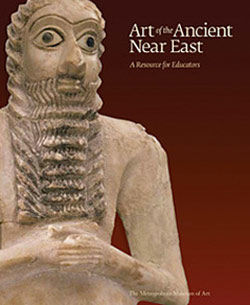Benzel, Kim, Sarah B. Graff, Yelena Rakic, and Edith W. Watts (2010)
Many features of civilization originated in the lands we call the ancient Near East, a vast and varied area from Turkey to the Indus Valley of present-day Pakistan and from the Caucasus to the Arabian Peninsula. This essential guide for K–12 educators introduces the variety and diversity of art produced by the rich and complex cultures that flourished in this region during an equally vast time period, from the eighth millennium B.C. to the middle of the seventh century A.D. Learn about the cultural, archaeological, and historical contexts for a selection of thirty works of art in the form of sculpture, silver and gold ritual vessels and objects, monumental reliefs, cuneiform tablets, and stamp and cylinder seals. Curriculum connections, discussion questions, lesson plans, and activities for a range of grade levels provide useful strategies for teaching in the classroom. The resource also includes a bibliography and glossary.These educational materials are made possible by Rolin Foundation USA.
Table of contents Goals and Design of this ResourceMaps of the Ancient Near East
The Ancient Near East
Resources in the Ancient Near EastChronology of the Ancient Near EastIntroduction to Ancient Near Eastern Art and Archaeology
Uncovering the Ancient Near East Through ArchaeologyA Brief History of the Ancient Near East
Dating Near Eastern HistoryCuneiform MessagesAnimals and HumansThe Royal ImageCommunicating with the Divine
The AfterlifeMaterials and TechniquesQuick List of the Works of ArtDescriptions of the Works of ArtClassroom Applications
National Standard for Education: Curriculum ConnectionsLesson Plans
Writing and Art
The Multifaceted Animal
The Royal Image
Gods, Goddesses, and the SupernaturalClassroom Activities
Topics for Discussion for Older StudentsSelected Resources
Bibliography for Teachers and Students
Online ResourcesGlossary










 Stumble It!
Stumble It!

No comments:
Post a Comment